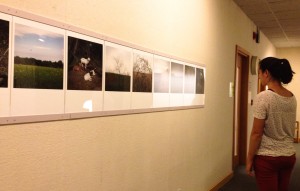By Kane Balser
balserka@grinnell.edu
Nature-lovers and the artistically inclined will be interested in seeing the exhibit in Burling Gallery, “Constructing Nature” by photographer Garrett Hansen ’02. Hansen took the photos at the Conard Environmental Research Area (CERA), tracking the seasonal changes there.
Hansen works as a photographer and is teaching a short course at the College. The course is called “Landscape Awareness,” and is offered through Environmental Studies.
“One of the questions that led me to go out to CERA…was this question of how do we construct this idea of nature—what is nature?” Hansen said.
Hansen lived in an apartment at CERA, rising with the dawn to explore this question through his photography.
The Center for Prairie Studies, which collaborated with Hansen on this project, has been bringing artists out to CERA since its foundation in 1999, said Jonathan Andelson, Director of the Center and Anthropology professor.
“One thing I really value about the Center for Prairie Studies, and what it’s doing, is that it’s allowing the humanities to have a voice in that space,” Hansen said, “and I think that voice is part of the dialogue that’s surrounding these places.”
Through the College, CERA has mostly been used for the natural sciences, a purpose for which it was initially created.
“We all get used to looking at a space in one way. Trying to look at it in a diversity of ways can be really enriching,” Hansen said. “Something that’s so nice about being in a liberal arts setting is that there’s more of a dialogue between the disciplines, and that’s encouraged.”
Past artists who have made works at, or been inspired by, CERA include Sandy Skoglund, Gino Hollander and Andy Goldsworthy. Goldsworthy’s piece, a prairie cairn, is still standing at the site.
The cairn was a project Goldsworthy was working on with the Des Moines Art Center. His project was to build cairns across America—the East Coast, the Midwest and the West Coast. For the Midwest installment, he wanted to construct a cairn in the midst of the prairie. The Des Moines Arts Center called Andelson with suggestions, and Goldsworthy ended up choosing CERA.
Art professors have also made work around CERA, in addition to taking classes to work there. Former professor Will Pergl frequently took classes there, as does Lee Running, Art.
Hansen is aware of the extent to which places like CERA have inspired other artists.
“This body of work…sort of sits in a larger set of concerns,” he said. “For me, as a photographer, the goal isn’t to just make a pretty photograph. It’s to use this as an expressive, thoughtful medium,” Hansen said. “That demands doing your research before hand, identifying the issues, thinking about your feelings on them, and how you might want to communicate your thoughts visually.”
Those concerns include the debate over what nature is and whether or not people constitute a place in our idea of nature. Another concern is over the relationship between the intentionality of a space and nature.
Hansen’s work also explores the tension between the conceptual and experiential aspect of spaces, in terms of how one thinks of a space, versus how one feels in it.
The photos depict the spaces of CERA, including fields, forests, and the river. Many of them show evidence of human interaction with the environment, contrasting the wildness of the place. This wildness takes on a new meaning when we realize it has been created, or recreated, by people.
“Garrett is joining a long and distinguished tradition of artists reflecting on the natural world,” Andelson said.
Past artists who have explored this topic in the Midwest include George Catlin and Karl Bodme, and more regionalist artists like Grant Wood, Thomas Hart Benton and Jon Stewart Curry.
“How do we express our relationship to the land? That’s the central question,” Andelson said.
Following up on the mixture of art and science at CERA, the landscape class Hansen is teaching is quite interdisciplinary as well, with students from Biology, Psychology, Anthropology, and the Studio Arts.
“That just enriches the conversations that we can have,” Hansen said.
These conversations can extend beyond the classroom, as we think about the value of preserving natural habitats like the prairie, for these varied purposes.
“I would hope people would come and see the images, and also go out and experience [CERA] for themselves, and maybe think about some of the issues that go along with it,” Hansen said.
Visiting CERA can be a challenge for students, who often lack both the means of transportation and the time. The trip is worth it, though, and opportunities like volunteering provide the means to access CERA.
In the meantime, those who wish to visit CERA may be appeased by visiting Hansen’s exhibit in Burling basement, a wonderful experience in its own right.





























































